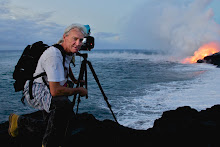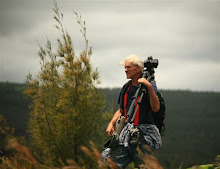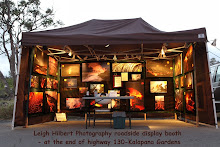 Pele's monitor at 11:00 AM this morning.
Pele's monitor at 11:00 AM this morning.The USGS/HVO deformation - Deflation/Inflation: electronic tilt monitors are recording a pulse-like graph this week, similar to a heart monitor — Makes me wonder if Pele is in a stable and restful mode right now; taking a break from further expansion after an intense couple of months.
 Ocean entry at 6:00 AM yesterday
Ocean entry at 6:00 AM yesterdayThis stable action continues manifesting on the coastal flats in the form of no surface breakouts and a steady flow of lava out off the edges of the deltas created between July 25th and today.
There are a few smaller ocean entry dribbles west of the main entry point about 1200-feet away, but most of the lava on the new benches flows into the sea across one central section directly south-southeast of the tube system providing it, which is this fuming area below:

 Eastern edge of the main ocean entry early yesterday morning
Eastern edge of the main ocean entry early yesterday morning
~~~~~~~~~~~~~~~~~~~~~~~~~~~~~~~~~~~~~~~~~~~~~~~~~~~~~~~~~~~~~~~~~~~~~
Coastal lava viewing
Yes there will be lava sights to be seen from the viewing road even though the eruption intensity has diminished down in that area: fuming/degassing lines down the mountainside, the slim possibility of vegetation fires or lava breakouts near or far, vast areas of shiny new lava fields with fumes wafting from them, and steam rising into the air where lava continues entering the ocean a mile away and will glow red-orange after dark.
The county viewing area is located at the terminus of Highway 130 near Kalapana. For direct information on what is being seen from the viewing area each day you can phone the JanGuard security staff, stationed right on site, between 2:00 PM and 10:00 PM daily at (808) 430-1966 or the Lava Viewing Hotline: 961-8093
Halema’uma’u Crater
The Halema’uma’u crater has been degassing sulfur dioxide fumes by day and glowing strongly at times after dark from lava deep within the craters pit vent. The broiling molten lava moves up and down inside this massive eruptive vent at times, in kind of a pistoning action. Great views of this impressive crater are from the Jaggar Museum balcony within the Hawaii Volcanoes National Park, depending on the weather; and the park is open to the public 24 hours a day with a nominal entrance fee by day.























+Leigh+Hilbert+Photography_D69D0201.jpg)








































